You know the age old question, “what came first, the chicken or the egg”? Well, the same question can be asked about butterflies. Monarch butterflies, and I assume all other butterflies, go through several stages in their relatively short lives. They start as a tiny little egg, and end as a beautiful butterfly. But we need a butterfly to produce the egg, right? So what really did come first, the butterfly or the egg? That is a question that will probably never be answered.
Instead of trying to answer a question that will probably never be answered, let’s focus on the real reason you are reading this article: the life cycle of the Monarch butterfly. This is something that I was interested in, too, when I first started our butterfly garden a few years ago. And I will admit, I am still amazed by the whole process. Nature really is amazing when you stop to think about it, or have the pleasure of witnessing it first hand.
The Monarch goes through 4 stages during its life:
- Egg
- Caterpillar (Larvae)
- Chrysalis (Pupa)
- Butterfly
*Note that all time frames listed below are dependent on temperature. In cooler weather, it could take a little longer.
Egg: 3 to 5 days
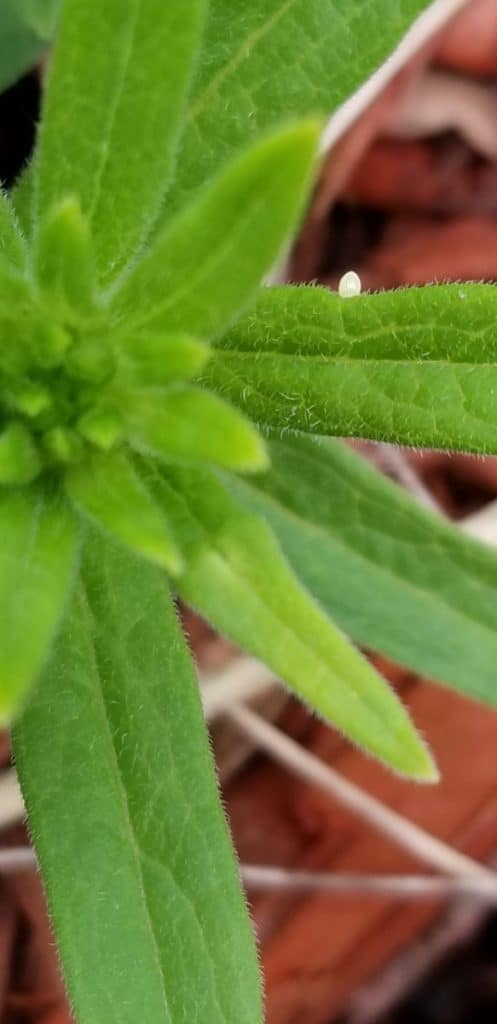
The Monarch butterfly begins its life as an egg. Although you can’t tell in the picture above, the eggs are tiny. Some have described them as being the size of a pinhead or the tip of a pencil, so if you can visualize one of those, that should give you an idea of how small they are. The eggs are whitish or off-white in color, and have ridges that run from the tip to the base.
Since the milkweed plant is the only host plant that a Monarch caterpillar can eat, the female Monarch butterfly searches for milkweed when she is ready to lay her eggs. While it is not completely known how exactly a Monarch butterfly finds milkweed, it is believed that it use a combination of senses to identify milkweed plants.
Once they land on a plant, they use sensory organs in their feet to identify it as a milkweed. I have observed this is my own garden. I happened to catch a female Monarch flying between various plants in the garden, and after observing her for a few minutes, I realized what she was doing. When she landed on a milkweed, she would lay an egg. When she landed on a Black-eyed Susan, or other plant, she would not lay an egg and continued to fly to different plants until she found another milkweed to lay an egg on. It is interesting to note that she does not lay all of her eggs at once and does not lay them all on the same milkweed plant.
A single female Monarch butterfly can lay between 200 and 500 eggs over the span of a couple of weeks. I read somewhere that a single female Monarch laid over 1,000 eggs while in captivity. That’s a lot of eggs! Three to 5 days after the egg is laid, the top of the egg will appear dark. This is the head of the caterpillar inside the egg, and a sign that it should be hatching soon.
Caterpillar (Larvae): 9 to 14 days
After the caterpillar emerges from the egg, one of the first things it will do is eat the egg shell. I actually got lucky and was able to catch a newly hatched caterpillar eating its egg:
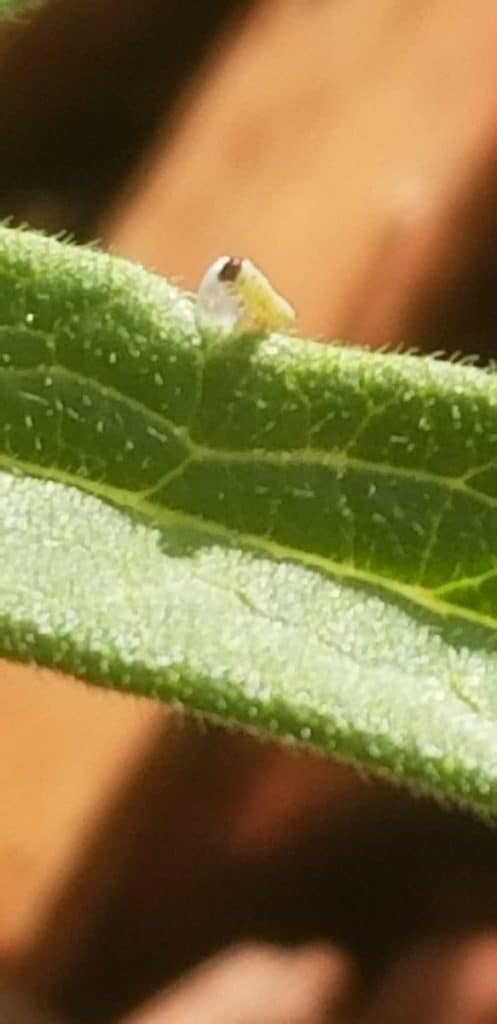
One thing you might notice in the picture above is that the caterpillar doesn’t have its signature yellow, black and white colors. Don’t worry, those colors will come out soon.
After the caterpillar eats its egg, it will start eating milkweed. Lots and lots of milkweed! The Monarch caterpillar will spend the next 9 to 14 days doing 4 things: eating milkweed, sleeping, pooping, and molting (shedding its skin). A Monarch caterpillar can eat its own body weight in milkweed. While the freshly hatched Monarch caterpillar may be tiny, it doesn’t stay that way for long. Its estimated that over the next 9 to 14 days it will be 3,000 times bigger than the day it hatched from the egg. As it grows, it will literally outgrow its skin. It will then shed its skin (a process called molting) so that it can continue to grow. After the caterpillar molts, it will often eat the layer of skin it left behind before continuing to chow down on milkweed.
The intervals between molts are called instars. Monarch go through 5 instars before reaching the chrysalis, or pupa, stage. If you are wondering how to tell a female caterpillar from a male caterpillar, you can’t. You can however, tell a female butterfly from a male butterfly. See the butterfly section below.
- 1st Instar
- Body length: 2 to 6 mm (0.08 to 0.24 inches)
- Time at this stage: 1 to 3 days
The time between when the Monarch caterpillar first hatches and its first molt is the 1st instar. During this instar, the Monarch caterpillar will not display its trademark yellow, black, and white stripes. See pic above.
- 2nd Instar
- Body length: 6 to 9 mm (0.24 to 0.35 inches)
- Time at this stage: 1 to 3 days
After the caterpillar sheds its skin the first time, its signature colors come out.
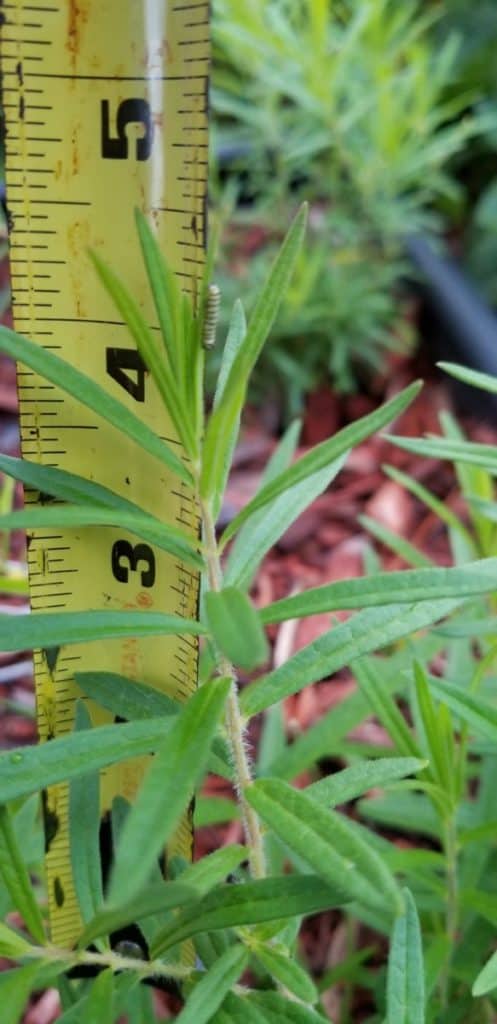
- 3rd Instar
- Body length: 9 to 14 mm (0.35 to 0.55 inches)
- Time at this stage: 1 to 3 days
- 4th Instar
- Body length: 14 to 25 mm (0.55 to 0.98 inches)
- Time at this stage: 1 to 3 days
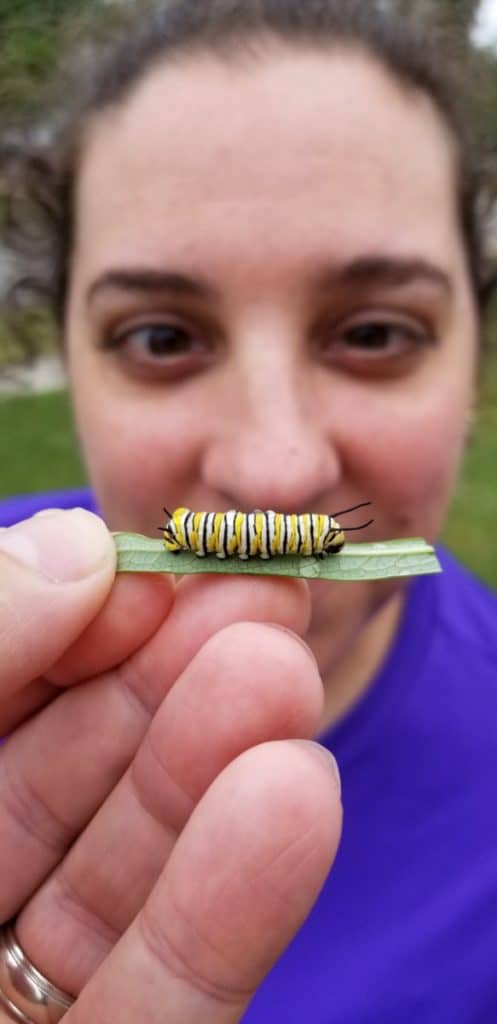
- 5th Instar
- Body length: 25 to 45 mm (0.98 to 1.77 inches)
- Time at this stage: 3 to 5 days
This is the final instar. Once the caterpillar reaches its full size, it will find a safe place to begin the next phase of its life. If you find a Monarch caterpillar this size wandering away from a milkweed plant, that’s usually a sign that its ready to begin forming its chrysalis. It’s not uncommon to find a caterpillar wandering 30 or 40 feet from a milkweed plant to find the perfect spot.
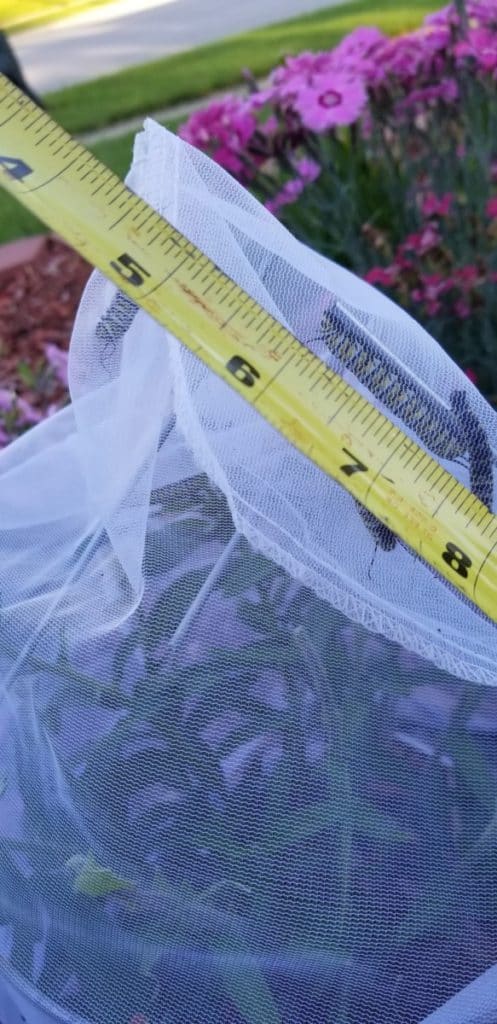
Chrysalis (Pupa): 8 to 15 days
When the Monarch caterpillar is ready to begin its transformation (or metamorphosis), it usually wanders away from the milkweed plant to find the safe spot to form its chrysalis (or pupate). I sometimes hear people refer to the chrysalis as a cocoon, but this is incorrect. A cocoon is made of silk, and while many moths and caterpillars do spin a silk cocoon, the Monarch caterpillar does not. Instead, it oozes a protein layer that eventually hardens and keeps it protected as it starts to transform into a butterfly. While it’s common to think that all of a Monarch’s metamorphosis takes place within the chrysalis, changes have already begun within the caterpillar.
When the caterpillar finds the perfect spot to form its chrysalis, it will attach a silk mat from which to hang upside down from. Once the silk mat is ready, the caterpillar will attach itself to it, and hang upside down in a J formation. This is sometimes referred to as the “hanging J”. The caterpillar will hang like this for about 24 hours before the chrysalis starts to form. Watching a Monarch form its chrysalis is really cool to watch. It’s like its body splits open and green slime oozes out. It will wiggle back and forth as it covers itself in it. Once it is done covering itself from head to toe, it will stop moving and just hang there until the chrysalis hardens.
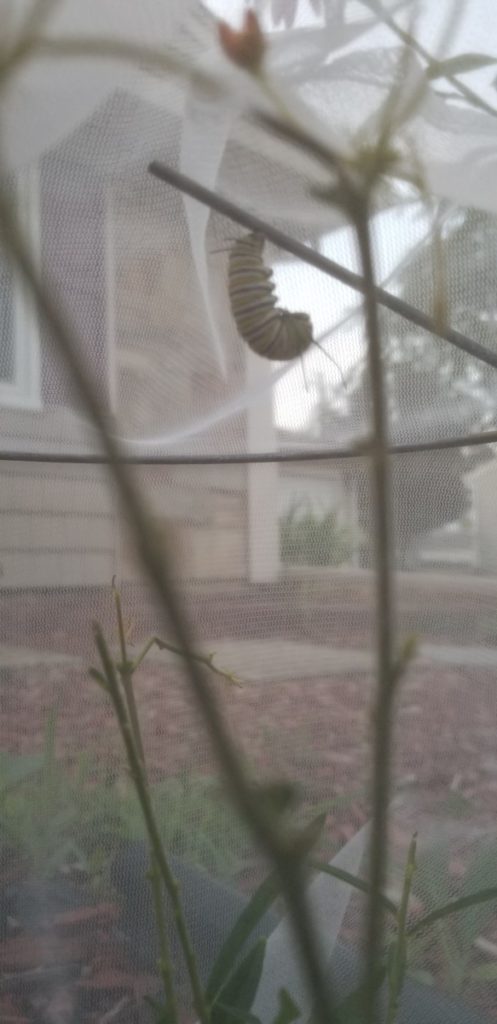
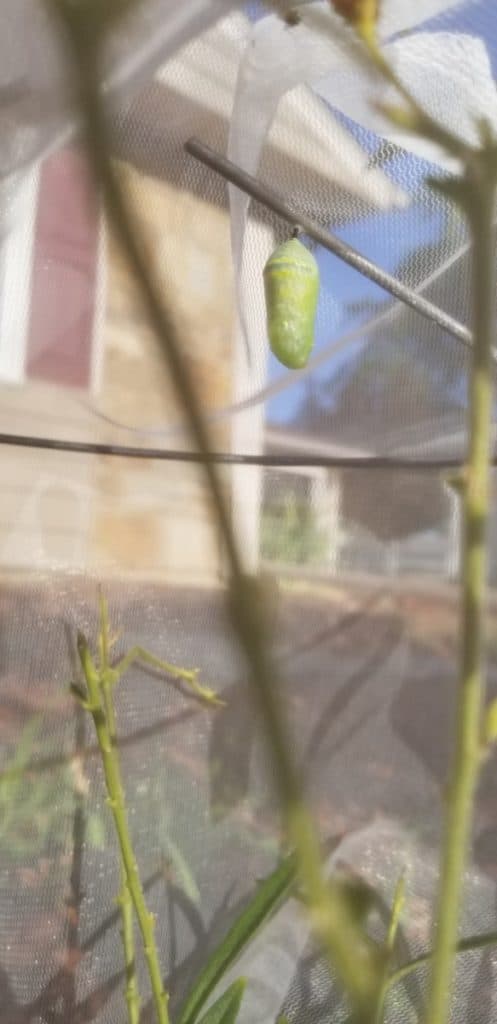
The Monarch chrysalis is typically green in color which helps keep it camouflaged against the surrounding plants. You will also notice some gold spots on the outside of the chrysalis. While this has stumped researchers and scientists for a long time, Richard Stringer, a biologist, seems to have found the answer while conducting studies on Monarch chrysalises using various types of X-rays, MRIs, and X-ray microtomography. Those gold dots appear to be a way for oxygen to get into the chrysalis.
After being in its chrysalis for 8 to 15 days, the Monarch butterfly will be ready to emerge, or eclose. You will know when the Monarch butterfly is almost ready to eclose from its chrysalis when the chrysalis no longer looks green and instead looks dark. If you look closely, you can see black and orange inside. See image below. In my experience, if I notice that a chrysalis has turned dark in the evening, a butterfly will emerge the next morning. All of my Monarch have eclosed in the morning, usually between the hours of 8:30 am and 11:00 am. This is another amazing thing to watch.
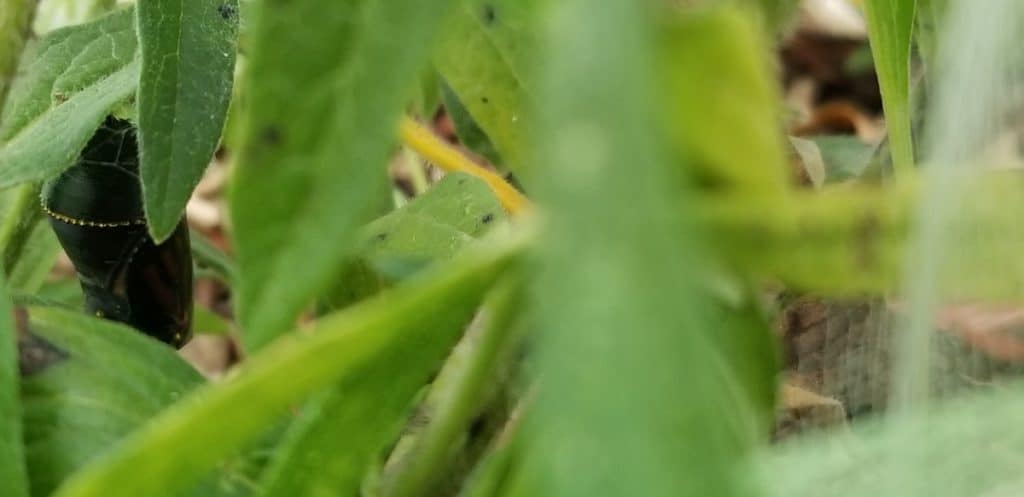
Butterfly (Adult): 2 weeks to 6-8 months
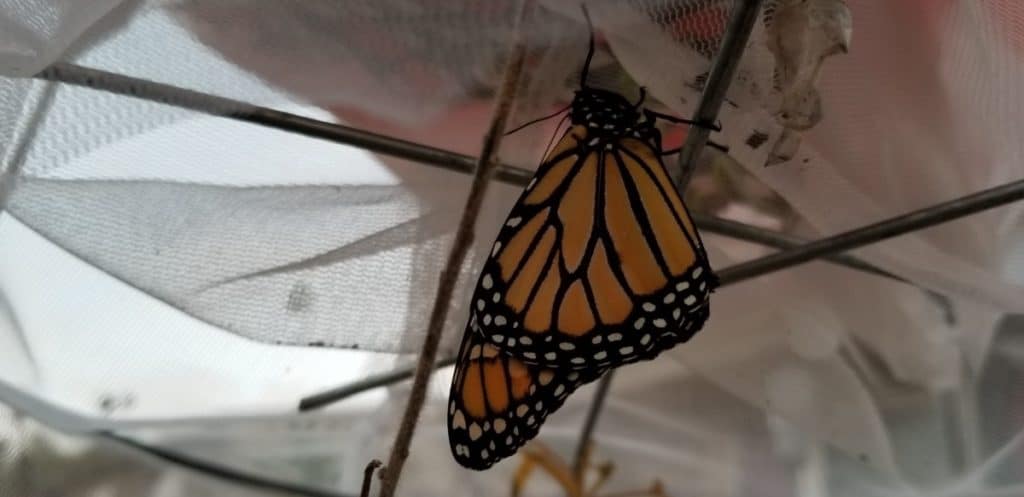
When a Monarch butterfly first ecloses (emerges) from its chrysalis, its wings will be small, wet and crumpled, and its abdomen will look large. It still has a little bit of work to do before it looks like a Monarch butterfly. As caterpillars, Monarchs eat milkweed with their mouths, but as butterflies, they drink nectar from flowers using their proboscis. Think of it as a straw. When the Monarch first emerges from the chrysalis, the proboscis needs to be fused together.
The reason its abdomen appears so large is because it is filled with a fluid called hemolymph. Hemolymph is similar to blood in humans. The butterfly will pump this fluid into its wings and it will start looking more and more like a Monarch butterfly. When it has finished pumping the fluid into its wings, it will need to hang upside down so that their wings can dry. It is important not to disturb a butterfly during its “drying cycle” and that it has enough room to fully extend its wings while they are drying. I made the mistake of “helping” a butterfly out of a cage before he was ready. His wings weren’t fully dry and I saw fluid falling off his wings as he flew away. He flew far enough that I lost site of him. A neighbor later found him laying in their lawn. I picked him up and noticed that his right wing was deformed. He tried to fly out of my hand, but only made it a few feet before he ended up on the ground again. So if you see a butterfly that has recently emerged from its chrysalis, and is hanging upside down, it’s best to let him (or her) be. Once its wings are dry, it is ready to take its first flight. And it is a miraculous site. Knowing that just a few weeks ago it was a tiny egg that you could barely see and now it is a full grown butterfly. It really boggles the mind.
As I mentioned previously in this article, it is impossible to distinguish a female caterpillar from a male caterpillar. You can, however, tell a female and male Monarch butterfly apart. One of the easiest ways to tell if it’s male or female is to look at its wings. A male Monarch butterfly will have thinner veins in its wings than a female and it will have 2 spots on its hind wings next to its abdomen. You can sometimes see these spots when his wings are closed, but it is much easier to see them when his wings are open and you can see the top of the wings. The way I remember that the male is the one with the 2 dots is that a male human has 2 testicles. These dots produce pheromones that attract female Monarch butterflies.
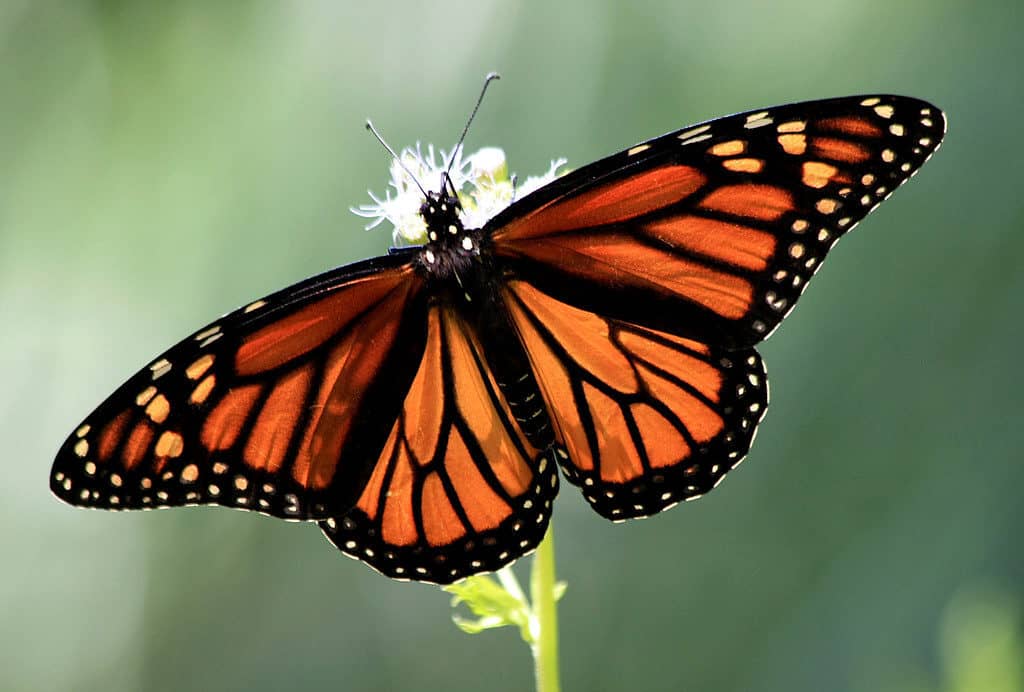
(“Monarch 03” by TexasEagle is licensed under CC BY-NC 2.0)
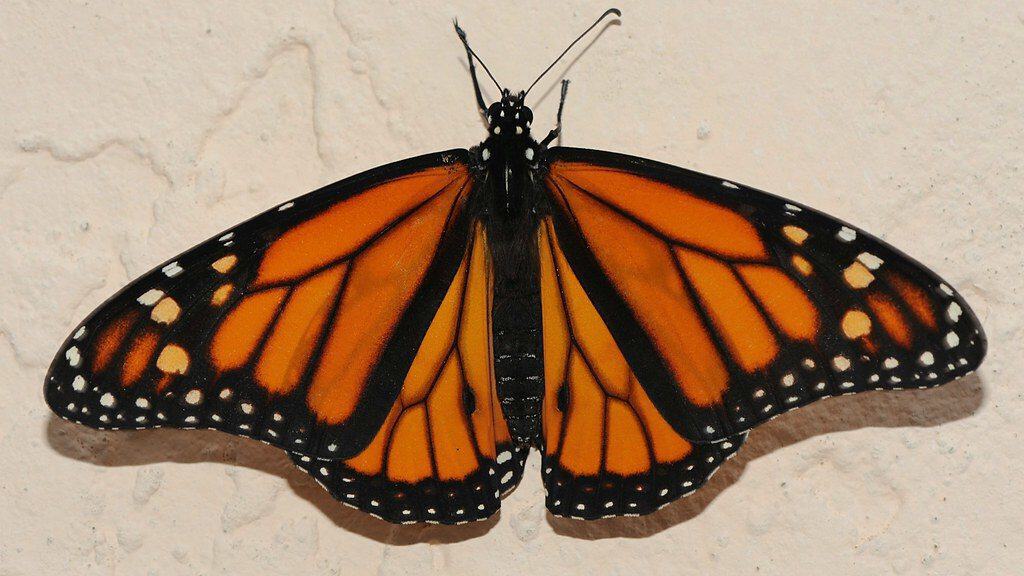
(“Newly Emerged Monarch” by vladeb is licensed under CC BY-ND 2.0 )
Once the male finds a female to mate with, he uses his two claspers on the end of his abdomen to hold the female. Female Monarchs can mate intermediately after emerging from the chrysalis, but the male needs a day or two before he can mate. Both males and female Monarch butterflies can mate several times during their lifespan.
Like humans, the female Monarch butterfly produces eggs that need to be fertilized by the sperm of the male Monarch butterfly. Once the eggs are fertilized, they are ready to laid on milkweed plants and the life cycle starts over again. If you were doing the math you would realize that time between when an egg is laid and when the egg of next generation is laid can happen in as little as 3 weeks. Each year Monarchs go through 4 or 5 generations from the time they leave hibernation in Mexico, travel north through the US and Canada, and return to Mexico to hibernate over the winter. Adult butterflies of most generations only live 2 to 6 weeks. The final generation of the year is different. Somehow the generation that overwinters in Mexico lives 6 to 8 months. The butterflies that spend the winter in Mexico do not mate or reproduce until they start their journey north in the spring.
So there you have it. The Monarch butterfly goes through 4 stages in its life. It starts as an egg, hatches as a caterpillar, metamorphosizes in a chrysalis, and emerges as a butterfly. Having witnessed this entire process in my own garden, it simply blows me away. It’s just amazing to watch.
